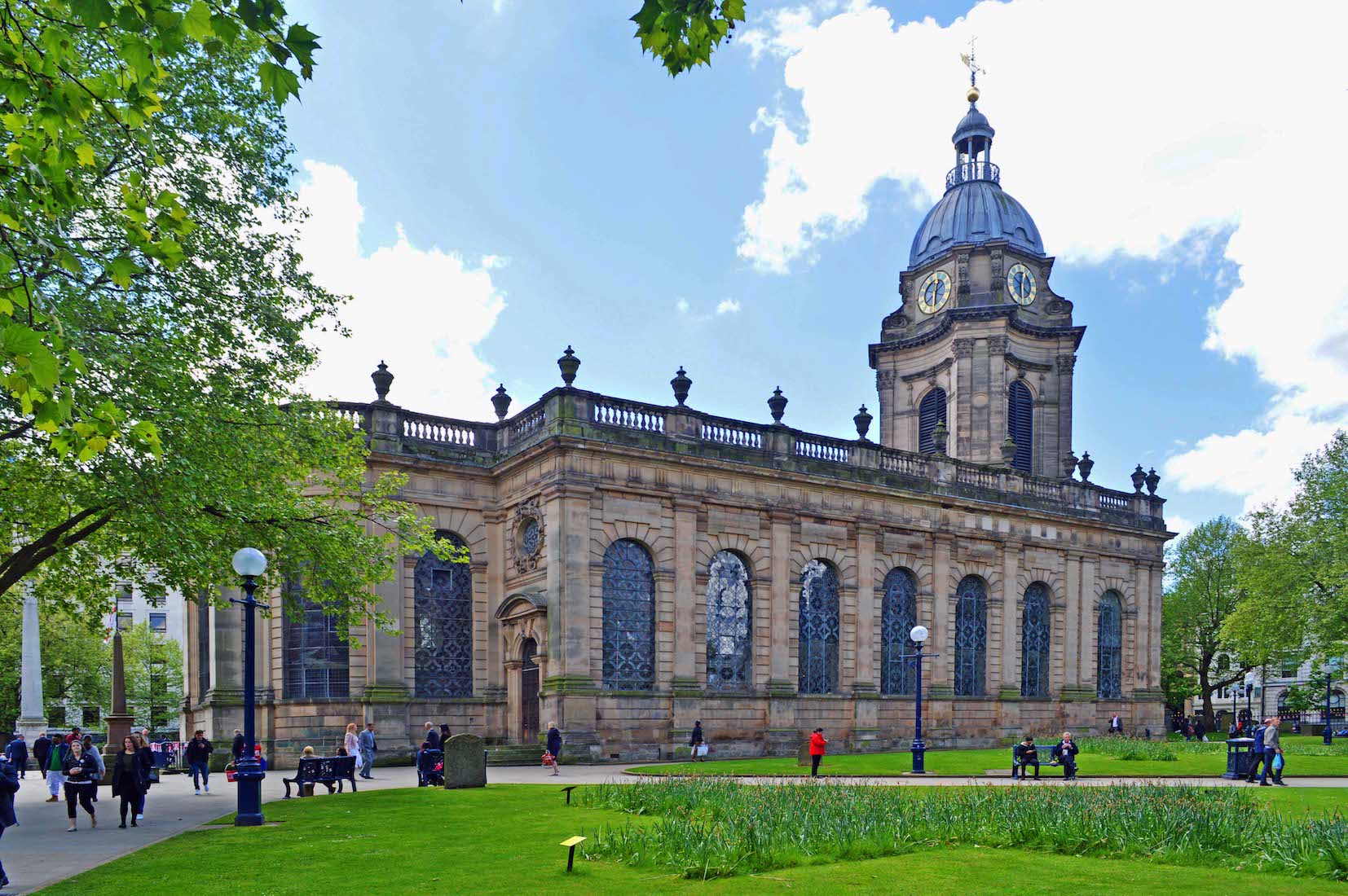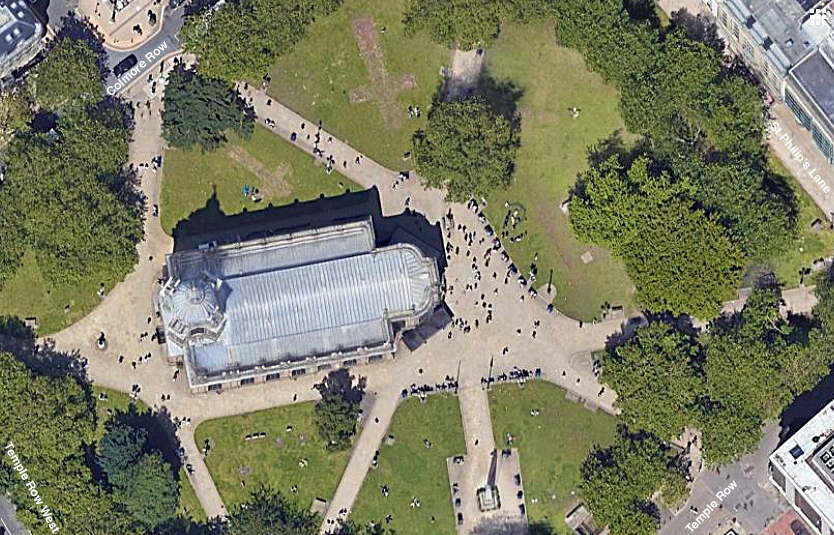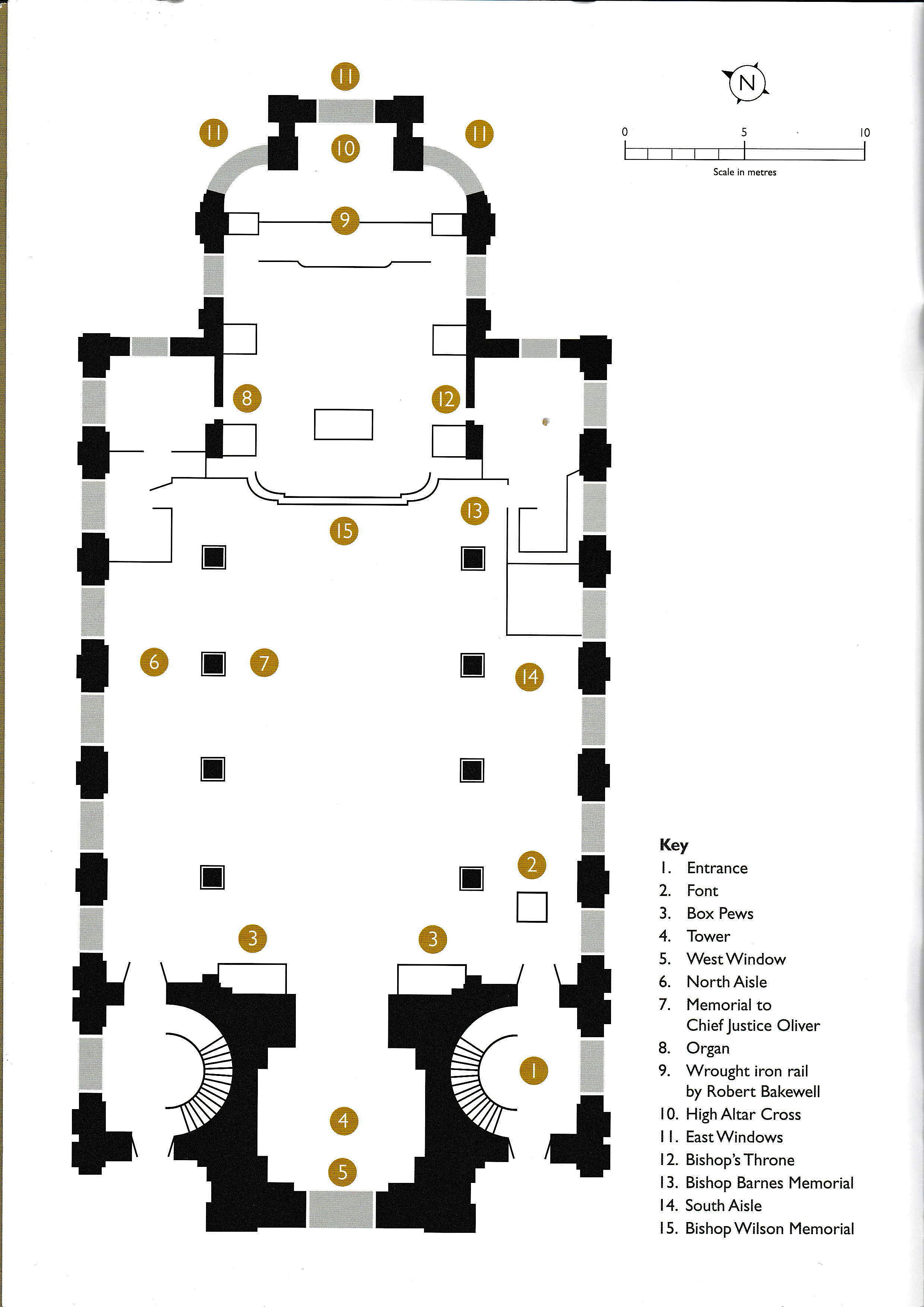 WELCOME TO
WELCOME TO
BIRMINGHAM CATHEDRAL
WEST MIDLANDS ENGLAND
PAUL SCOTT

SATELLITE VIEW
In the centre of the city on a hill is Cathedral Square – an area of parkland surrounding the Cathedral. Thr parkland is bounded by Colmore Row, Temple Row West, Temple Row, and St Philip’s Lane. The Cathedral sanctuary faces almost due east – close enough for us to identify our liturgical directions (for example, East with a capital E) with the geographical equivalents (east). The Cathedral is essentially rectangular in shape with an apse extending at the East end, and a large central tower at the West end. The park is obviously popular, especially with the lunchtime crowds.
This Cathedral plan has some of the key features numbered. In contrary fashion, but following the pattern of many other cathedrals on this site, we shall follow our own way, beginning with a complete circuit of the exterior of the Cathedral. We then make our way around the interior, finishing at the sanctuary. The plan gives a better understanding of the extended apse at the top (East end), and the complex foyer arrangement around the base of the tower at bottom (West end). The Cathedral actually has two side balconies running the length of the nave: this explains the semicircular staircases in the foyer block.
Some history of the Cathedral is given below, but you can begin your tour of this Cathedral by clicking on
Some intermediate points in the tour can be accessed immediately by a tap / click on the links below:
NOTE ON MAGNIFYING IMAGES
With this website format the images are large enough for most purposes. If there is a need for greater magnification of an image, go to the identical photo on
https://www.flickr.com/photos/paulscottinfo/albums
and use Command - + (Mac) or Windows - + (Windows).

HISTORY
[Wikipedia]
The Cathedral Church of Saint Philip is the Church of England Cathedral and the seat of the Bishop of Birmingham. Built as a parish church and consecrated in 1715, St Philip’s became the Cathedral of the newly formed Diocese of Birmingham in 1905. St Philip’s was built in the early 18th century in the Baroque style by Thomas Archer. The Cathedral is a Grade I listed building. St Philip’s is the third smallest cathedral in England after Derby and Chelmsford.
St Philip’s Church was planned when the nearby medieval church of St Martin in the Bull Ring became insufficient to house its congregation because of the growing population of Birmingham. The land, previously named the Barley Close, was donated by Robert Philips in 1710. It is one of the highest points in the district and is said to be at the same level as the cross on St Paul’s Cathedral in London. Following an Act of Parliament, construction commenced in 1711, to the design of Thomas Archer, and was ready for consecration in 1715, when it was dedicated to the Apostle Philip as a tribute to the benefactor Robert Philips. It appears to have been Archer’s first church, apart from a rebuilt chancel at Chicheley attributed to him. Construction was estimated to cost £20,000, but the final figure was only £5,012 (equivalent to £790,000 in 2019). This was because many of the materials were donated and transported to the site at no cost. St Philip's served as a Parish church from 1715 to 1905. The church contained St. Philip’s Parish Library which was bequeathed to the church by William Higgs. In 1792 a library room was constructed next to the parsonage house by Spencer Madan and was named the Parochial Library.
A Cathedral
With the growth of industrial towns in the 18th and 19th centuries, there was a consequent growth in the number of parishes, and a need for new administrative centres. Birmingham became a city in 1889. While the cities of Liverpool and Truro constructed new cathedrals, in a number of other cities existing churches and ancient abbeys were raised to the administrative status of cathedrals. Through the actions of the statesman Joseph Chamberlain and the Bishop of Worcester, Charles Gore, St Philip’s became the Cathedral of Birmingham in 1905, with Charles Gore as its first bishop.
Second World War
During the Second World War, the Cathedral was bombed and gutted on 7 November 1940. Its most significant treasures, several windows by Edward Burne-Jones, had been removed in the early stages of the war by the Birmingham Civic Society, and were replaced, unharmed, when the building was restored in 1948.
Architecture
The dome of the western tower St Philip’s was designed by Thomas Archer and constructed between 1711 and 1715. The tower was complete by 1725, and the urns on the parapet were added in 1756. Archer had visited Rome and his design, in the Baroque style, was influenced by the churches of Borromini, being rather more Italianate than churches by Christopher Wren. The rectangular hall church interior has aisles separated from the nave by fluted pillars of classical form with Tuscan capitals supporting an arcade surmounted by a heavily projecting cornice. Wooden galleries are stretched between the pillars in a manner typical of English Baroque churches. Externally, the tall windows are interspaced by pilasters in low relief, supporting a balustrade at roof level with an urn rising above each pilaster. The western end is marked by a single tower which rises in stages and is surmounted by a lead-covered dome and a delicate lantern. The building is of brick and is faced with stone quarried on Archer’s estate at Umberslade. The original shallow eastern apse was extended in 1884 – 88 by J. A. Chatwin into a much larger chancel, articulated by strongly projecting Corinthian columns. This bold design is made richer by the marbled surfaces of the columns and pilasters, the gilding of capitals and cornice and the ornately coffered ceiling. Chatwin also refaced the exterior of the building because the stone from the original quarry was very soft. The tower was refaced in 1958-59. Edward Burne-Jones, who was born in nearby Bennett’s Hill and baptised in the church, added to the enhancement of St Philip’s by the donation of several windows, of which three are at the eastern end. The West window, also by Burne-Jones, was dedicated in memory of Henry Bowlby in 1897.


